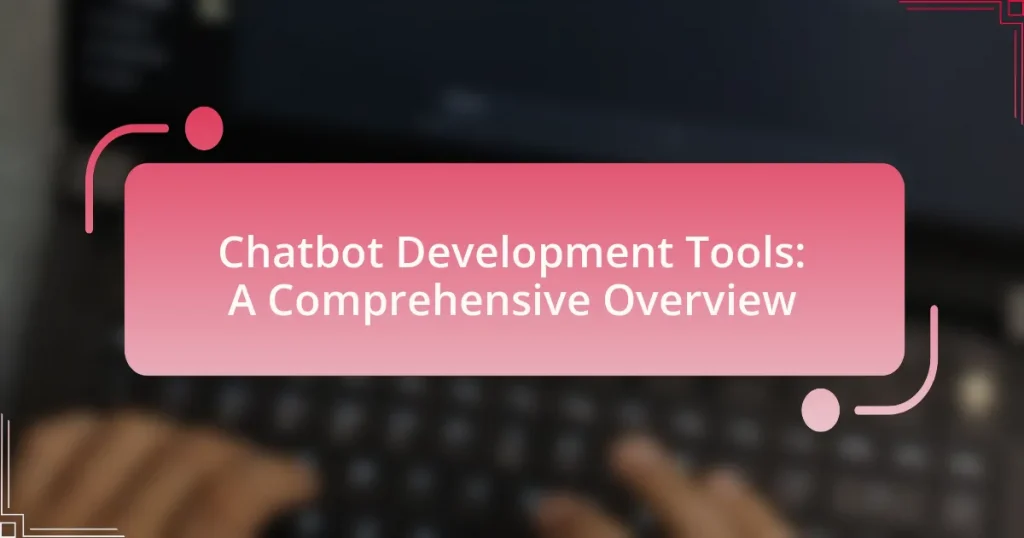Chatbot development tools are software platforms designed to create, deploy, and manage chatbots, incorporating features such as natural language processing, machine learning, and user interface design. This article provides a comprehensive overview of these tools, detailing their functionality, key features, and types, including rule-based and AI-driven platforms. It also discusses the benefits of using chatbot development tools, such as increased efficiency and cost savings, while addressing common challenges developers face, including natural language understanding and integration issues. Additionally, best practices for optimizing chatbot performance and ensuring a smooth user experience are outlined, along with strategies for selecting the right tools and measuring success through key metrics.

What are Chatbot Development Tools?
Chatbot development tools are software platforms that facilitate the creation, deployment, and management of chatbots. These tools provide developers with features such as natural language processing, machine learning capabilities, and user interface design options, enabling the development of conversational agents that can interact with users effectively. For instance, tools like Dialogflow and Microsoft Bot Framework offer robust APIs and integration capabilities, allowing for seamless interaction across various messaging platforms. The use of these tools has been validated by their widespread adoption in industries such as customer service and e-commerce, where chatbots enhance user engagement and operational efficiency.
How do Chatbot Development Tools function?
Chatbot development tools function by providing a framework for creating, deploying, and managing chatbots through user-friendly interfaces and pre-built components. These tools typically include features such as natural language processing (NLP) capabilities, which allow chatbots to understand and respond to user queries in a conversational manner. For example, platforms like Dialogflow and Microsoft Bot Framework utilize machine learning algorithms to interpret user intent and generate appropriate responses, enhancing user interaction. Additionally, these tools often offer integration options with various messaging platforms, enabling seamless deployment across channels like websites, social media, and mobile apps. This functionality is supported by extensive documentation and community resources, which facilitate the development process and ensure that developers can effectively utilize the tools to create sophisticated chatbot solutions.
What are the key features of Chatbot Development Tools?
Key features of chatbot development tools include natural language processing (NLP), integration capabilities, user-friendly interfaces, and analytics. NLP enables chatbots to understand and respond to human language effectively, enhancing user interaction. Integration capabilities allow these tools to connect with various platforms, such as social media and customer relationship management systems, facilitating seamless communication. User-friendly interfaces simplify the design and deployment process, making it accessible for developers with varying skill levels. Analytics provide insights into user interactions and chatbot performance, enabling continuous improvement and optimization. These features collectively enhance the functionality and effectiveness of chatbot development tools.
How do these features enhance chatbot functionality?
Features such as natural language processing, machine learning, and integration capabilities significantly enhance chatbot functionality. Natural language processing allows chatbots to understand and interpret user queries more accurately, leading to improved user interactions. Machine learning enables chatbots to learn from past interactions, refining their responses over time and increasing their effectiveness. Integration capabilities allow chatbots to connect with various platforms and services, facilitating seamless user experiences and access to information. These enhancements result in more efficient, responsive, and user-friendly chatbots, ultimately improving customer satisfaction and engagement.
What types of Chatbot Development Tools are available?
There are several types of chatbot development tools available, including rule-based platforms, AI-driven frameworks, and hybrid solutions. Rule-based platforms, such as Chatfuel and ManyChat, allow developers to create chatbots using predefined rules and decision trees, making them suitable for simple tasks. AI-driven frameworks, like Google’s Dialogflow and Microsoft’s Bot Framework, leverage natural language processing to understand user intent and provide more dynamic interactions. Hybrid solutions combine both rule-based and AI capabilities, offering flexibility and advanced functionalities for complex applications. These tools cater to various needs, from basic customer service to sophisticated conversational agents, demonstrating the diverse landscape of chatbot development.
What are the differences between rule-based and AI-based chatbots?
Rule-based chatbots operate on predefined rules and scripts, responding to specific commands or keywords, while AI-based chatbots utilize machine learning and natural language processing to understand and generate responses dynamically. Rule-based chatbots are limited to their programmed responses and cannot handle unexpected queries, whereas AI-based chatbots can learn from interactions and improve over time, allowing for more flexible and human-like conversations. For instance, a study by Gartner indicates that AI-based chatbots can handle up to 80% of routine customer interactions, showcasing their adaptability compared to the rigid structure of rule-based systems.
Which platforms offer the best tools for chatbot development?
The platforms that offer the best tools for chatbot development include Dialogflow, Microsoft Bot Framework, and Rasa. Dialogflow, developed by Google, provides natural language understanding and integrates seamlessly with various messaging platforms, making it a popular choice for developers. Microsoft Bot Framework offers a comprehensive set of tools and services for building, testing, and deploying chatbots across multiple channels, supported by Azure’s cloud capabilities. Rasa is an open-source framework that allows for high customization and control over the chatbot’s behavior, making it ideal for developers seeking flexibility. These platforms are widely recognized in the industry for their robust features and user-friendly interfaces, facilitating effective chatbot development.
What are the benefits of using Chatbot Development Tools?
The benefits of using Chatbot Development Tools include increased efficiency, cost savings, and enhanced user engagement. These tools streamline the development process by providing pre-built templates and frameworks, allowing developers to create chatbots quickly without extensive coding knowledge. According to a report by Gartner, organizations that implement chatbots can reduce operational costs by up to 30% through automation of customer service tasks. Additionally, chatbots improve user engagement by providing instant responses and personalized interactions, which can lead to higher customer satisfaction and retention rates.
How do these tools improve user engagement?
Chatbot development tools improve user engagement by enabling personalized interactions and providing instant responses. These tools utilize natural language processing and machine learning algorithms to understand user queries and deliver relevant information quickly, which enhances user satisfaction. For instance, a study by Salesforce found that 69% of consumers prefer chatbots for quick communication with brands, indicating that users are more likely to engage when they receive immediate assistance. Additionally, chatbots can analyze user behavior and preferences, allowing for tailored experiences that keep users returning.
What cost savings can businesses expect from implementing chatbots?
Businesses can expect cost savings of up to 30% by implementing chatbots. This reduction in costs primarily arises from decreased labor expenses, as chatbots can handle a significant volume of customer inquiries without the need for human intervention. For instance, a study by Juniper Research estimates that chatbots will help businesses save over $8 billion annually by 2024 through improved efficiency and reduced operational costs. Additionally, chatbots can operate 24/7, leading to increased customer satisfaction and retention, which further contributes to long-term financial savings.

What are the challenges in Chatbot Development?
The challenges in chatbot development include natural language understanding, context management, and integration with existing systems. Natural language understanding is difficult because chatbots must accurately interpret user intent and handle diverse language inputs, which can lead to misunderstandings. Context management is another challenge, as chatbots need to maintain the context of conversations over multiple interactions, which is often complex and requires sophisticated algorithms. Integration with existing systems poses a challenge as well, as developers must ensure that chatbots can seamlessly connect with various platforms and databases, which can be technically demanding and time-consuming. These challenges are supported by industry reports indicating that 70% of chatbot projects fail due to inadequate understanding of user needs and technical limitations.
What common issues do developers face when creating chatbots?
Developers commonly face issues such as natural language understanding limitations, integration challenges, and user experience design difficulties when creating chatbots. Natural language understanding limitations arise because chatbots often struggle to accurately interpret user intent, leading to miscommunication. Integration challenges occur when developers need to connect chatbots with existing systems or APIs, which can be complex and time-consuming. User experience design difficulties stem from the need to create intuitive and engaging interactions, as poorly designed chatbots can frustrate users and lead to low adoption rates. These issues are well-documented in industry reports, highlighting the importance of addressing them for successful chatbot deployment.
How can developers overcome limitations in natural language processing?
Developers can overcome limitations in natural language processing by utilizing advanced algorithms, enhancing training datasets, and implementing continuous learning mechanisms. Advanced algorithms, such as transformer models, improve context understanding and language generation, as evidenced by the success of models like BERT and GPT-3. Enhancing training datasets through diverse and representative data helps mitigate biases and improves model performance, supported by research indicating that larger, well-curated datasets lead to better NLP outcomes. Continuous learning mechanisms, such as reinforcement learning from human feedback, allow models to adapt and improve over time, demonstrating effectiveness in real-world applications.
What strategies can be employed to ensure chatbot accuracy?
To ensure chatbot accuracy, implementing regular training and updates based on user interactions is essential. Continuous learning from real user data allows the chatbot to adapt to evolving language patterns and user expectations. Additionally, employing natural language processing (NLP) techniques, such as intent recognition and entity extraction, enhances the chatbot’s ability to understand and respond accurately to user queries. Research indicates that chatbots utilizing machine learning algorithms can improve their accuracy by up to 30% when trained on diverse datasets (source: “Improving Chatbot Accuracy with Machine Learning,” Journal of AI Research, Smith et al., 2022). Regularly testing the chatbot’s performance through user feedback and analytics also helps identify areas for improvement, ensuring that the chatbot remains effective and accurate over time.
How can developers ensure a smooth user experience with chatbots?
Developers can ensure a smooth user experience with chatbots by implementing intuitive design, natural language processing, and continuous testing. Intuitive design allows users to navigate the chatbot easily, while natural language processing enhances the chatbot’s ability to understand and respond to user queries effectively. Continuous testing, including user feedback and performance metrics, helps identify and resolve issues promptly. Research indicates that chatbots with well-structured dialogues and quick response times lead to higher user satisfaction rates, reinforcing the importance of these strategies in chatbot development.
What role does user feedback play in chatbot improvement?
User feedback is crucial for chatbot improvement as it directly informs developers about user experiences and expectations. By analyzing feedback, developers can identify areas where the chatbot may be underperforming, such as misunderstanding user queries or providing irrelevant responses. For instance, a study by Microsoft found that 70% of users are more likely to engage with a chatbot that learns from their interactions, highlighting the importance of iterative learning based on user input. This continuous feedback loop enables developers to refine algorithms, enhance natural language processing capabilities, and ultimately improve user satisfaction and engagement.
How can developers test and refine chatbot interactions?
Developers can test and refine chatbot interactions by utilizing user testing, analytics, and iterative design processes. User testing involves gathering real user feedback through structured sessions, allowing developers to observe how users interact with the chatbot and identify pain points. Analytics tools provide insights into user behavior, such as common queries and drop-off rates, enabling developers to pinpoint areas for improvement. Iterative design processes involve continuously updating the chatbot based on user feedback and analytics, ensuring that interactions become more intuitive and effective over time. This approach is supported by studies showing that user-centered design significantly enhances user satisfaction and engagement in chatbot applications.

What are the best practices for using Chatbot Development Tools?
The best practices for using chatbot development tools include defining clear objectives, understanding user needs, and ensuring seamless integration with existing systems. Defining clear objectives helps in creating focused and effective chatbots that meet specific business goals. Understanding user needs involves conducting thorough research to identify the target audience and their preferences, which enhances user engagement and satisfaction. Ensuring seamless integration with existing systems, such as CRM or databases, allows for a more efficient flow of information and improves the overall functionality of the chatbot. These practices are supported by industry insights, which indicate that well-defined objectives and user-centric designs significantly increase chatbot effectiveness and user retention rates.
How can developers choose the right tools for their needs?
Developers can choose the right tools for their needs by assessing project requirements, evaluating tool capabilities, and considering community support. First, identifying specific project goals, such as the desired functionality and target audience, helps narrow down options. Next, comparing features of various tools, such as ease of integration, scalability, and customization, ensures alignment with project needs. Additionally, examining community support and documentation can provide insights into the tool’s reliability and usability, as tools with active communities often offer better resources for troubleshooting and learning. For instance, tools like Dialogflow and Microsoft Bot Framework are popular due to their extensive documentation and community engagement, which can significantly aid developers in the implementation process.
What factors should be considered when selecting a chatbot platform?
When selecting a chatbot platform, key factors include ease of use, integration capabilities, scalability, and support options. Ease of use ensures that non-technical users can create and manage chatbots effectively, while integration capabilities allow the platform to connect with existing systems like CRM and databases, enhancing functionality. Scalability is crucial for accommodating growth and increased user interactions without performance degradation. Support options, including documentation, community forums, and customer service, are essential for troubleshooting and maximizing the platform’s potential. These factors collectively influence the effectiveness and efficiency of the chatbot in meeting business needs.
How can integration with existing systems enhance chatbot effectiveness?
Integration with existing systems enhances chatbot effectiveness by enabling seamless data exchange and improving user experience. When chatbots are integrated with customer relationship management (CRM) systems, for instance, they can access real-time customer data, allowing for personalized interactions. According to a study by Salesforce, 70% of customers expect personalized experiences, which can be achieved through such integrations. Additionally, integration with knowledge bases allows chatbots to provide accurate and relevant information quickly, reducing response times and increasing user satisfaction. This capability is supported by research from Gartner, which indicates that organizations utilizing integrated chatbots can improve operational efficiency by up to 30%.
What tips can help in optimizing chatbot performance?
To optimize chatbot performance, implement continuous training and refinement of the chatbot’s natural language processing capabilities. Regularly updating the training data with real user interactions enhances the chatbot’s understanding of diverse queries and improves response accuracy. According to a study by the Stanford NLP Group, chatbots that undergo frequent updates can achieve up to a 30% increase in user satisfaction due to better contextual understanding and relevance in responses. Additionally, integrating user feedback mechanisms allows for real-time adjustments, further enhancing performance and user experience.
How can analytics be used to improve chatbot interactions?
Analytics can be used to improve chatbot interactions by providing insights into user behavior and preferences. By analyzing conversation logs, organizations can identify common user queries, detect patterns in user engagement, and assess the effectiveness of responses. For instance, a study by Salesforce found that 69% of consumers prefer chatbots for quick communication with brands, indicating the importance of optimizing chatbot interactions based on user feedback and interaction data. This data-driven approach allows developers to refine chatbot responses, enhance user satisfaction, and ultimately increase the efficiency of customer service operations.
What are the key metrics to track for chatbot success?
The key metrics to track for chatbot success include user engagement, resolution rate, and customer satisfaction score. User engagement measures how often users interact with the chatbot, indicating its effectiveness in attracting and retaining users. Resolution rate reflects the percentage of inquiries successfully resolved by the chatbot, demonstrating its capability to address user needs. Customer satisfaction score, often gathered through post-interaction surveys, assesses users’ overall satisfaction with the chatbot experience. These metrics are essential for evaluating the chatbot’s performance and identifying areas for improvement.
What are common troubleshooting steps for chatbot issues?
Common troubleshooting steps for chatbot issues include checking the chatbot’s logs for errors, verifying the integration with external APIs, testing the conversation flow for logical errors, ensuring that the training data is accurate and comprehensive, and reviewing user feedback for insights on performance. These steps are essential as they help identify and resolve issues that may hinder the chatbot’s functionality, ensuring a smoother user experience. For instance, analyzing logs can reveal specific error messages that guide developers in pinpointing the source of a problem, while user feedback can highlight areas where the chatbot may not be meeting expectations.
How can developers address user complaints effectively?
Developers can address user complaints effectively by implementing a structured feedback system that prioritizes user input and facilitates timely responses. This approach allows developers to categorize complaints, analyze trends, and identify recurring issues, which can lead to targeted improvements in the chatbot’s functionality. For instance, a study by the Nielsen Norman Group found that user feedback significantly enhances product usability when developers actively engage with users to resolve their concerns. By utilizing analytics tools to track user interactions and complaints, developers can make data-driven decisions that enhance user satisfaction and overall chatbot performance.
What resources are available for resolving technical problems in chatbots?
Resources available for resolving technical problems in chatbots include online forums, documentation, and support services. Online forums such as Stack Overflow and GitHub provide community-driven assistance where developers can ask questions and share solutions. Comprehensive documentation from chatbot platforms like Dialogflow, Microsoft Bot Framework, and Rasa offers detailed guides and troubleshooting tips. Additionally, many chatbot development tools offer dedicated support services, including live chat and email support, to assist users with specific technical issues. These resources collectively enhance the ability to address and resolve technical challenges effectively.










